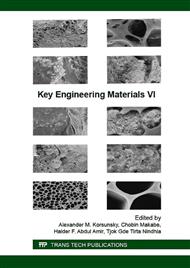p.315
p.323
p.332
p.338
p.345
p.350
p.357
p.362
p.368
Compressive Strength and Water Penetration of Concrete with Enterococcus faecalis and Calcium Lactate
Abstract:
This paper presents the compressive strength and water penetration of Bioconcrete with calcium lactate. The bacteria used in this concrete is Enterococcus faecalis, which was isolated and enriched to suit the concrete environment. Bioconcrete is a sustainable and environmentally friendly method to improve concrete properties, but the natural production of calcite by the bacteria is limited. Therefore, the objective of this research is to add in calcium lactate as additional food source for the bacteria and determine the effect on the compressive strength and water penetration of concrete. The Bioconcrete is fabricated in the standard size of 150mm × 150mm × 150mm cubes. The calcium lactate added into the mix is in concentrations of 0.001 mol/l, 0.005mol/l and 0.01 mol/l measured according to the amount of water used in fabrication. Both compressive strength and water penetration is tested after the 28th day by using Universal Testing Machine (UTM) and Water Permeability testing machine respectively. It is found that by adding calcium lactate into Bioconcrete, the compressive strength improves by a maximum of 16.4% which is 41.9 Mpa using the concentrations of 0.005 mol/l of calcium lactate. Compared to control which was 36 Mpa and concrete with only Enterococcus faecalis of 38.2 Mpa. The water penetration has a similar trend of decreasing the water penetration of concrete with Enterococcus faecalis and calcium lactate. A maximum decrease of water penetration is from calcium lactate of concentration 0.01 mol/l of 26.2% which is 8.7 cm compared to control of 11.8 cm and concrete with only Enterococcus faecalis of 9.2 cm. Adding calcium lactate as an additional food source for bacteria in concrete has positive results and further study with the same concept is encouraging
Info:
Periodical:
Pages:
345-349
Citation:
Online since:
August 2016
Authors:
Price:
Сopyright:
© 2016 Trans Tech Publications Ltd. All Rights Reserved
Share:
Citation:


